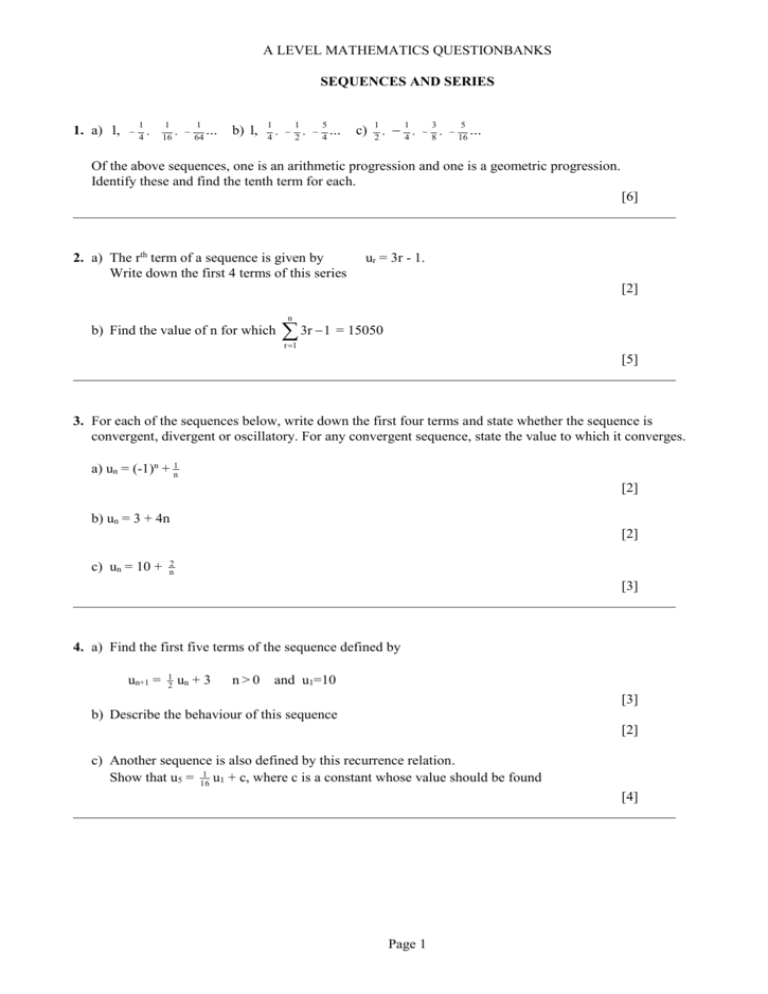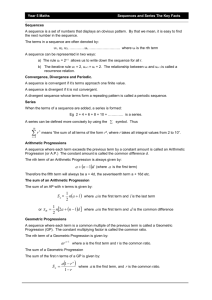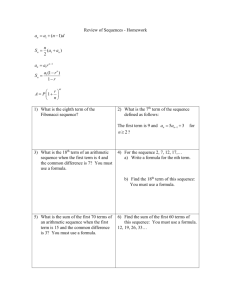Sequences and Series Questions
advertisement

A LEVEL MATHEMATICS QUESTIONBANKS SEQUENCES AND SERIES 1. a) 1, 1 , 4 1 1 , ... 16 64 b) 1, 1 1 5 , , ... 4 2 4 c) 1 , 2 4, 1 3 5 , ... 8 16 Of the above sequences, one is an arithmetic progression and one is a geometric progression. Identify these and find the tenth term for each. [6] 2. a) The rth term of a sequence is given by Write down the first 4 terms of this series ur = 3r - 1. [2] n b) Find the value of n for which 3r 1 = 15050 r 1 [5] 3. For each of the sequences below, write down the first four terms and state whether the sequence is convergent, divergent or oscillatory. For any convergent sequence, state the value to which it converges. a) un = (-1)n + n1 [2] b) un = 3 + 4n [2] c) un = 10 + 2 n [3] 4. a) Find the first five terms of the sequence defined by un+1 = 1 2 un + 3 n>0 and u1=10 [3] b) Describe the behaviour of this sequence [2] c) Another sequence is also defined by this recurrence relation. Show that u5 = 161 u1 + c, where c is a constant whose value should be found [4] Page 1 A LEVEL MATHEMATICS QUESTIONBANKS SEQUENCES AND SERIES 5. An arithmetic progression has first term -5 and a common difference 4. a) Find the nth term in terms of n. [2] b) The kth term has the value 99. Find the value of k. [2] c) The sum of the first M terms of the progression is greater than 1700. Find the smallest possible value of M. [4] 6. In an arithmetic progression, the sum of the first 10 terms is 170 and the 8th term is 32. Find the first term and the common difference [6] 7. A series has sum to n terms given by: Sn = 2n + 3n2 a) Find the first 3 terms of the series [4] b) By evaluating Sn - Sn-1, find a formula for the nth term of the series [4] c) Hence show it is an arithmetic progression [2] 8. In a geometric series, the sum to infinity is 27, and the sum of the first two terms is 24. a) Find the two possible values for the common ratio [6] b) Find the corresponding two possible values for the first term [2] 9. The second term of a geometric progression is 1, and the fourth term is The third term is negative. 1 16 . a) Find the value of the common ratio [4] b) Explain why the sum to infinity exists, and find this sum. [4] Page 2 A LEVEL MATHEMATICS QUESTIONBANKS SEQUENCES AND SERIES 10. When Ben started work, he was offered a starting salary of £13 000 per year, with a yearly increase of 8% a) Show the amounts of his annual salaries form a geometric series, and write down its common ratio [3] b) Find Ben’s salary in his tenth working year [1] c) Find the total amount Ben earns in his first ten years [2] 11. a) Given that a, b, and c are three successive terms of a geometric progression, show that b2 = ac [3] An arithmetic progression has first term a and common difference d, where d > 0 . b) Given that the first, second and fourth terms of this arithmetic progression form a geometric progression, show that a = d [5] c) Given that the sum of the first five terms of the arithmetic progression is 60, find a. [2] d) Given that the sum of the first n terms of the arithmetic progression is 924, find n. [3] 12. In a geometric series, the second term is -36 and the sum to infinity is 48. Find the possible value(s) for the common ratio and the 1st term. [8] 13. An arithmetic series has third term 11. The ninth term is five times the second term. a) Find the common difference [6] b) Find the value of n for which un un+1 = 2397, where ur is the rth term of the arithmetic series [5] 20 14.Find 3(2 r ) 3r 4 r 1 [8] Page 3 A LEVEL MATHEMATICS QUESTIONBANKS SEQUENCES AND SERIES 15.a) Punita takes seven maths tests during a school year. Her mark on the first test is 52%. Her successive marks, in order, form an arithmetic progression with common difference d. (Only integer marks are allowed) i) Find the complete range of possible values of d [5] ii) Show that her mean mark for the year is equal to her mark in the fourth test [3] b) Rita takes the same seven tests, and her successive marks also form an arithmetic progression. Her first mark was 98%. Her third mark was equal to Punita’s seventh mark. Her sixth mark was one more than Punita’s second mark. i) Find the value of the common difference for Rita’s marks. [5] ii) Find Punita’s average mark for the year. [3] 16. a+b, 2a+2, 2a+b, 3b - 1 are successive terms in an arithmetic progression. a) Find a and b [6] b) Given that a+b is the fifth term of the progression, find a simplified expression for its sum to n terms [3] 17. A person starting a job is offered the following two pay schemes: Scheme A: Starting salary £1250 per month. Increases of £d each month Scheme B: Starting salary £15000 per year. Increase of 3% each year based on the pay received in the immediately preceding year. a) If the schemes are to pay the same after four years, find the value of d to the nearest penny. [6] b) Find the number of years required for his salary to increase by 20% using each scheme. [9] Page 4 A LEVEL MATHEMATICS QUESTIONBANKS SEQUENCES AND SERIES 18. A ball is dropped from a height of 6m onto a floor. After each bounce, it rises to half the height achieved in the immediately preceding bounce. a) Taking un as its height after the nth bounce, express un+1 in terms of un. [1] b) Explain why the series un forms a convergent geometric series, and find its sum to infinity [4] c) Hence obtain the total distance travelled by the ball [3] 19. t+1 and t2 – 1, where t 1, are the first two terms of a convergent geometric progression. a) Obtain the common ratio in its simplest possible form [2] b) Show that 0<t<1 or 1<t<2 [2] c) Given the sum to infinity is equal to one, find t. [3] 20. The arithmetic series A has a common difference of 242 and the geometric series G has a common ratio of 3. Given that A and G have the same first term and the same sixth term, find a) the first term [4] b) the sum of the first 6 terms in each case [4] 21. The sum of the second and third terms of a geometric series is six times the fourth term. a) Find possible non-zero values for the common ratio. [4] b) Given that the first term of the series is 7, find the possible sum to infinity of the series. [3] Page 5 A LEVEL MATHEMATICS QUESTIONBANKS SEQUENCES AND SERIES 22. Given that p and q are the first and third terms respectively of an arithmetic series find the sum of the first nine terms. [5] 23.a) Show that r3 – 1 (r – 1)(r2 + r + 1) [2] 3 b) A geometric progression has nth term un. Given that u n 38 and u4 – u1 = 19, r 1 find the common ratio of the progression. [4] Page 6







